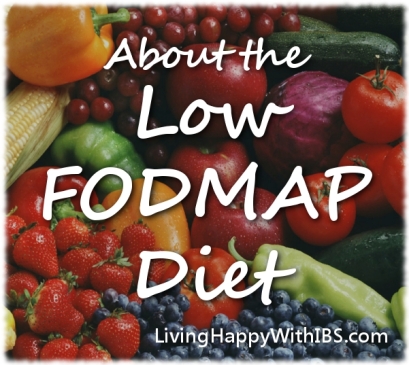After years of pain, gas and bloating, I found much relief after trying the low FODMAP diet. The low FODMAP diet is designed to eliminate key IBS symptom triggers for a few weeks and slowly introduce them back into your diet to better understand what your body can handle and what you should continue to avoid.
So, what is the low FODMAP diet? For starters, a group of scientists at Monash University (in Australia) have identified that short-chain carbohydrates, may be poorly absorbed by the small intestine, which causes IBS symptoms. These carbohydrates were given the acronym FODMAPs and refer to Fermentable Oligo-, Di- and Mono-saccharides, and Polyols. Not all carbohydrates are considered FODMAPs, so don’t worry about giving everything up just yet.

The FODMAPs in the diet are:
- Fructose is a carbohydrate found in many fruits, honey, high-fructose corn syrup (HFCS) and agave syrup. Fructose malabsorption is not completely digested due to the lack of an enzyme, but the absorption of fructose is dependent on another carbohydrate, which is glucose. Therefore, foods with a 1:1 ratio of fructose to glucose are generally well tolerated on the low FODMAP diet. However, foods with excess fructose compared with glucose, such as apples, pears, and mangos, will likely trigger IBS symptoms.
- Lactose is the carbohydrate found in cow, sheep, and goat milk. Lactose intolerance is caused by partial or complete lack of the enzyme lactase which digests lactose. When lactose is not completely digested, it contributes to abdominal bloating, pain, gas and diarrhea, usually occurring 30 minutes to two hours following the consumption of milk products.Foods high in lactose include milk, ice cream, yogurt and cottage cheese.
- Fructans are carbohydrates that are completely malabsorbed because the intestine lacks an enzyme to break their fructose bond. For this reason, fructans can contribute to bloating, gas and abdominal pain. Wheat accounts for the majority of people’s fructan intake, however it also occurs in onion, garlic and many other vegetables.
- Galactans are carbohydrates are malabsorbed for the same reason as fructans, which is that the intestine does not have the enzyme needed to break them down. Consequently, galactans can contribute to gas, bloating and abdominal pain. Beans and lentils are the primary galactans.
-
Polyols are also known as sugar alcohols. They are found naturally in some fruits and vegetables and a added as artificial sweeteners to sugar-free gum, mints and cough drops. Sugar alcohols have varying effects on the bowel. It is wise to limit your artificial sweeteners that end in -ol, such as sorbitol, xylitol, mannitol and maltitol. Splenda and aspartame are deemed safe on this diet, but many people experience bowel issues with these sweeteners, as well.
It should be noted that the low FODMAP diet is it not only what you eat, but in what quantities. Many people with IBS cannot digest large meals due to the cramping and diarrhea it causes. Personally I can always tell when I ate too much, even with all low FODMAP foods. My system just can’t take a large quantity of food, so I eat 200-300 calorie meals about 6 times a day. Even if I dine out, I usually save half and take it home.
For your convenience, here is a complete High FODMAP food list, which outlines what foods should be eliminated on the diet. After you read that (and get freaked-out), here’s some additional information that you’ll want to read:
- Getting Started on the Low FODMAP Diet
- Low FODMAP Foods to Enjoy
- Low FODMAP Diet Sample Meal Plan
- Adding Flavor without the FODMAPs
- Low FODMAP Brand Name Packaged Foods
- My Favorite Low FODMAP Products
- My Personal Collection of Low FODMAP Recipes
The way the diet was designed to work, is that you should do an elimination phase of 6-8 weeks and exclude all potentially harmful foods. After 6-8 weeks, you can slowly add one category back in at time to understand what is causing your IBS symptoms. Here’s detailed information on how to reintroduce FODMAPs back into your diet.
Great Low FODMAP Diet Resources:
- Monash University FODMAP Diet iTunes App. Expensive for an app at $9.99, but worth it! It contains a lot of information that you cannot find on their site. Also since they developed the diet, it can be trusted.
- Book: IBS-Free at Last!
by Patsy Catsos
- Book: Flavor without FODMAPs Cookbook
by Patsy Catsos
- Book: The Complete Low FODMAP Diet
by Sue Shepherd
- Book: The Complete Idiot’s Guide to Eating Well with IBS
by Kate Scarlata
- UPC Allergy Food Scanner. At $.99, it’s a great tag-along to the grocery store. Ensure you take the time to review all your settings (in every category) to check every food you should be avoiding. Don’t just assume you checked them all with the FODMAP setting.

I’m not going to sugar-coat it, the low FODMAP diet is difficult to incorporate into everyday life and I have had a few meltdowns to show for it. Luckily, I was already gluten and lactose free at the point I started it, but it was still very difficult for me to eliminate garlic and onions, which I miss everyday. However, I do not miss the pain that they cause me, so I can rest easy… literally.
I feel very strongly that this diet shouldn’t limit your life, it should limit your pain and discomfort to allow you to take on more adventures.